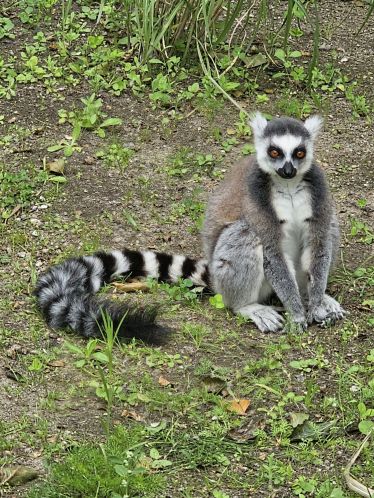- Marsupials (Diprotodontia)
- Carnivorous marsupials (Dasyuromorphia)
- Tenrec (Afrosoricida)
- Elephant shrew (Macroscelidea)
- Elephant (Proboscidea)
- Sea cows (Sirenia)
- Armadillos (Cingulata)
- Edentata (Pilosa)
- Treeshrew (Scandentia)
- Primate (Primates)
- Rodent (Rodentia)
- Bats (Chiroptera)
- Even-toed ungulate (Artiodactyla)
- Odd-toed ungulate (Perissodactyla)
- Carnivores (Carnivora)
Ring-tailed lemur (Lemur catta)

Picture taken in Ålborg, Denmark
The ring-tailed lemur (Lemur catta) is a large strepsirrhine primate and the most recognized lemur due to its long, black and white ringed tail. It belongs to Lemuridae, one of five lemur families, and is the only member of the Lemur genus. Like all lemurs it is endemic to the island of Madagascar and endangered. Known locally in Malagasy as maky or hira, it inhabits gallery forests to spiny scrub in the southern regions of the island. It is omnivorous and the most terrestrial of extant lemurs. The animal is diurnal, being active exclusively in daylight hours.
The ring-tailed lemur is highly social, living in groups of up to 30 individuals. It is also female dominant, a trait common among lemurs. To keep warm and reaffirm social bonds, groups will huddle together. The ring-tailed lemur will also sunbathe, sitting upright facing its underside, with its thinner white fur towards the sun. Like other lemurs, this species relies strongly on its sense of smell and marks its territory with scent glands. The males perform a unique scent marking behavior called spur marking and will participate in stink fights by marking their tail with their scent and wafting it at opponents.
As one of the most vocal primates, the ring-tailed lemur uses numerous vocalizations including group cohesion and alarm calls. Experiments have shown that the ring-tailed lemur, despite the lack of a large brain (relative to simiiform primates), can organize sequences, understand basic arithmetic operations and preferentially select tools based on functional qualities.
Despite reproducing readily in captivity and being the most populous lemur in zoos worldwide, numbering more than 2,000 individuals, the ring-tailed lemur is listed as endangered by the IUCN Red List due to habitat destruction and hunting for bushmeat and the exotic pet trade. As of early 2017, the population in the wild is believed to have crashed as low as 2,000 individuals due to habitat loss, poaching and hunting, making them far more critically endangered.
In Aquariums and Zoos: common in Europe
The ring-tailed lemur is highly social, living in groups of up to 30 individuals. It is also female dominant, a trait common among lemurs. To keep warm and reaffirm social bonds, groups will huddle together. The ring-tailed lemur will also sunbathe, sitting upright facing its underside, with its thinner white fur towards the sun. Like other lemurs, this species relies strongly on its sense of smell and marks its territory with scent glands. The males perform a unique scent marking behavior called spur marking and will participate in stink fights by marking their tail with their scent and wafting it at opponents.
As one of the most vocal primates, the ring-tailed lemur uses numerous vocalizations including group cohesion and alarm calls. Experiments have shown that the ring-tailed lemur, despite the lack of a large brain (relative to simiiform primates), can organize sequences, understand basic arithmetic operations and preferentially select tools based on functional qualities.
Despite reproducing readily in captivity and being the most populous lemur in zoos worldwide, numbering more than 2,000 individuals, the ring-tailed lemur is listed as endangered by the IUCN Red List due to habitat destruction and hunting for bushmeat and the exotic pet trade. As of early 2017, the population in the wild is believed to have crashed as low as 2,000 individuals due to habitat loss, poaching and hunting, making them far more critically endangered.
In Aquariums and Zoos: common in Europe
woaqzo@yahoo.com